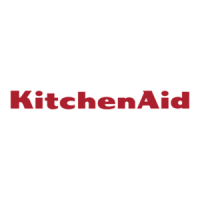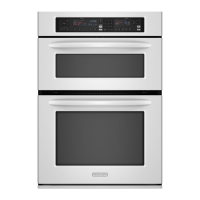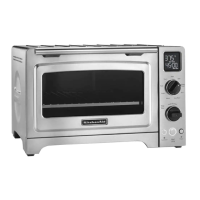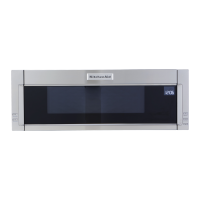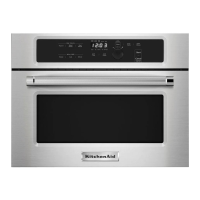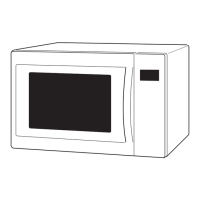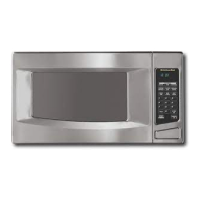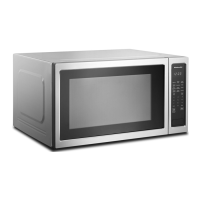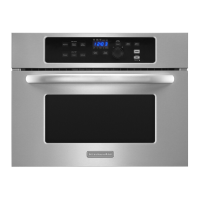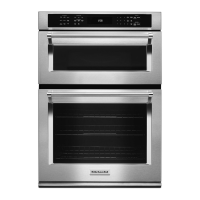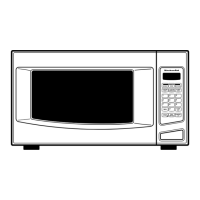16
Defrost
The Defrost feature can be used, or the microwave oven can be
manually set to defrost by using 30% cook power.
■ For optimal results, food should be 0°F (-18°C) or colder when
defrosting.
■ Unwrap foods and remove lids (from fruit juice) before
defrosting.
■ Shallow packages will defrost more quickly than deep blocks.
■ Separate food pieces as soon as possible during or at the end
of the cycle for more even defrosting.
■ Foods left outside the freezer for more than 20 minutes or
frozen ready-made food should not be defrosted using the
Defrost feature, but should be defrosted manually.
■ Use small pieces of aluminum foil to shield parts of food such
as chicken wings, leg tips and fish tails. See “Aluminum Foil
and Metal” first.
■ Times and cooking powers have been preset for defrosting
a number of food types.
■ Manual Defrost requires that a cook time and power level be
entered if using other than 30% cook power.
Use the following chart as a guide.
DEFROST CHART
*See the Defrost Preparation Chart at end of “Defrost” section
for cuts, sizes, and instructions.
Use the following chart as a guide when defrosting meat, poultry,
or fish.
DEFROST PREPARATION CHART
Steam Cooking
Steam Cook is a sensor cooking function that uses microwaves to
steam food. Always use steamer vessel. See the “KitchenAid™
Steamer Vessel” section before using. Use Steam Cook for foods
such as vegetables, fish and potatoes.
■ Times and cooking powers have been preset for steaming a
number of food types.
■ Manual Steam Cook requires that a cook time be entered.
■ It is recommended to add ½ cup (125 mL) of water to Steamer
Vessel before steaming.
Use the following chart as a guide.
STEAM COOKING CHART
Popcorn
■ Do not use regular paper bags or glassware.
■ Pop only 1 package of popcorn at a time.
■ Follow manufacturer’s instructions when using a microwave
popcorn popper.
■ Listen for popping to slow to 1 pop every 1 or 2 seconds, and
then stop the cycle. Do not repop unpopped kernels.
■ For best results, use fresh bags of popcorn.
■ Cooking results may vary by brand and fat content.
■ Recommended bag sizes are 3.5 oz, 3.0 oz, and 1.75 oz.
NOTE: Follow the instructions provided by the microwave popcorn
manufacturer.
Keeping Food Warm
Hot cooked food can be kept warm in the microwave oven.
■ Cover plates of food.
■ Cover foods that were covered while being cooked.
■ Do not cover baked goods such as pastries, pies, turnovers,
etc.
FOOD CODE WEIGHT
Poultry* 1 0.1 - 6.6 lbs (45 g - 3 kg)
Meats* 2 0.1 - 6.6 lbs (45 g - 3 kg)
Fish* 3 0.1 - 6.6 lbs (45 g - 3 kg)
Bread 4 0.1 - 2.0 lbs (45 g - 907 g)
Juice 5 6, 12 or 16 oz (177, 355 or 473 mL)
Manual 6 Default power level 30%
MEAT
Beef: ground, steaks, roast,
stew
The narrow or fatty areas of
irregular shaped cuts should
be shielded with foil before
defrosting.
Do not defrost less than
¼ lb (113 g) or two 4 oz (113 g)
patties.
Place all meats in microwave-
safe baking dish.
Lamb: stew and chops
Pork: chops, ribs, roasts,
sausage
POULTRY
Chicken: whole and cut up Place in microwave-safe
baking dish, chicken breast
side up.
Remove giblets from whole
chicken.
Cornish hens
Tur key: breast
FISH
Fillets, Steaks, Whole,
Shellfish
Place in microwave-safe
baking dish.
FOOD CODE QUANTITY
Potatoes 1 2-6 cups (500 mL-1.5 L)
Fresh vegetables 2 2-6 cups (500 mL-1.5 L)
Frozen vegetables 3 2-6 cups (500 mL-1.5 L)
Fish 4 8-16 oz (227-454 g)
Shrimp 5 5-10 oz (142-283 g)
Manual 6 Sensing
WARNING
Food Poisoning Hazard
Do not let food sit in oven more than one hour before
or after cooking.
Doing so can result in food poisoning or sickness.
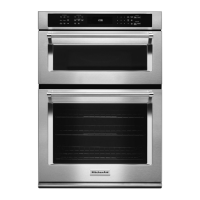
